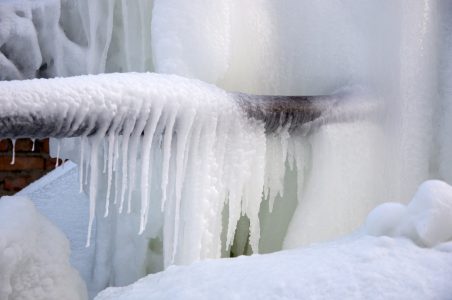Protecting Against Frozen Plumbing in Winter: Critical Advice
Protecting Against Frozen Plumbing in Winter: Critical Advice
Blog Article
The content listed below on the subject of How To Avoid Freezing Pipes is particularly remarkable. Give it a try and draw your own personal assumptions.

Cold weather can damage your plumbing, particularly by freezing pipelines. Below's how to stop it from taking place and what to do if it does.
Intro
As temperature levels decline, the risk of frozen pipes boosts, possibly leading to expensive repair work and water damages. Understanding exactly how to prevent frozen pipelines is crucial for house owners in chilly climates.
Avoidance Tips
Protecting prone pipelines
Wrap pipelines in insulation sleeves or make use of warmth tape to shield them from freezing temperature levels. Concentrate on pipelines in unheated or exterior areas of the home.
Home heating techniques
Maintain indoor rooms effectively heated up, specifically areas with pipes. Open up closet doors to permit warm air to flow around pipes under sinks.
Just how to identify icy pipelines
Seek decreased water flow from taps, uncommon odors or sounds from pipelines, and visible frost on revealed pipes.
Long-Term Solutions
Architectural adjustments
Take into consideration rerouting pipes away from exterior wall surfaces or unheated areas. Add added insulation to attic rooms, basements, and crawl spaces.
Upgrading insulation
Purchase top notch insulation for pipelines, attic rooms, and wall surfaces. Proper insulation helps preserve consistent temperatures and reduces the danger of frozen pipes.
Shielding Outdoor Pipes
Garden pipes and exterior faucets
Separate and drain pipes yard tubes prior to winter months. Mount frost-proof faucets or cover outside taps with protected caps.
Understanding Icy Pipelines
What creates pipelines to ice up?
Pipes freeze when exposed to temperatures listed below 32 ° F (0 ° C) for prolonged periods. As water inside the pipelines ices up, it broadens, taxing the pipeline wall surfaces and potentially creating them to break.
Dangers and problems
Frozen pipelines can result in supply of water disruptions, building damages, and expensive repair services. Burst pipelines can flood homes and trigger considerable structural damage.
Indicators of Frozen Water Lines
Identifying icy pipes early can prevent them from bursting.
What to Do If Your Pipes Freeze
Immediate actions to take
If you presume icy pipes, keep faucets open to alleviate stress as the ice thaws. Make use of a hairdryer or towels soaked in warm water to thaw pipes gradually.
Conclusion
Avoiding frozen pipelines needs positive steps and quick actions. By understanding the causes, indications, and safety nets, home owners can secure their plumbing throughout cold weather.
6 Proven Ways to Prevent Frozen Pipes and Protect Your Home
Disconnect and Drain Garden Hoses
Before winter arrives, start by disconnecting your garden hoses and draining any remaining water. Close the shut-off valves that supply outdoor hose bibs and leave the outdoor faucet open to allow any residual water to drain. For extra protection, consider using faucet covers throughout the colder months. It’s also important to drain water from any sprinkler supply lines following the manufacturer’s directions.
Insulate Exposed Pipes
Insulating your pipes is an effective way to prevent freezing. Pipe insulation is readily available at home improvement stores and is relatively inexpensive. Pay close attention to pipes in unheated areas such as the attic, basement, crawl spaces, or garage. Apply foam insulation generously to create a buffer against the cold. You can also wrap your pipes in heat tape or thermostat-controlled heat cables for added warmth.
Seal Air Leaks
Inspect your home for any cracks or openings that could let in cold air. Seal any holes around the piping in interior or exterior walls, as well as the sill plates where your home rests on its foundation. Additionally, make sure to keep your garage door closed unless you’re entering or exiting. Leaving it open creates a significant air leak that can lead to frozen pipes.
Allow Warm Air Circulation
During cold snaps, it’s essential to allow warm air to circulate evenly throughout your home. Leave interior doors ajar to promote better airflow. Open kitchen and bathroom cabinets to help distribute heat consistently around the rooms. If you have small children or pets, be sure to remove any household chemicals or potentially harmful cleaners from open cabinets for safety.
Let Faucets Drip
A small trickle of water can make a big difference in preventing ice formation inside your pipes. When temperatures drop significantly, start a drip of water from all faucets served by exposed pipes. This continuous flow helps prevent the water from freezing. Additionally, running a few faucets slightly can relieve pressure inside the pipes, reducing the chances of a rupture if the water inside does freeze.
https://choateshvac.com/6-proven-ways-to-prevent-frozen-pipes-and-protect-your-home/

I hope you enjoyed our excerpt about Helpful Tips to Prevent Frozen Pipes this Winter. Thanks for spending some time to browse our content. Do you know about somebody who is sincerely interested in the niche? Take a moment to promote it. Many thanks for taking the time to read it.
Visit My Website Report this page